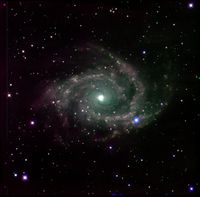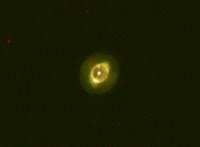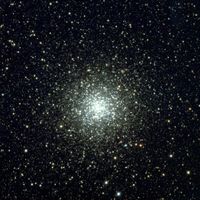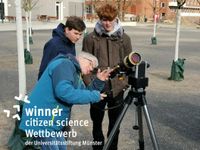Training for Teachers „Astronomy 2.0”
Teachers Training „Astronomy 2.0” at Pascal-Gymnasium Münster on Friday, September 25th, 2020
“Astronomy in school needs an upgrade!”
In the new “Physics” curriculum of the state of North Rhine-Westphalia/Germany, astronomy is given a new status, but knowledge of new digital possibilities for schools has generally remained in the 20th century.
This is where the AiM teacher training "Astronomy 2.0" comes in. With the help of the AiM , teachers in Münster and nearby learned how to access large research telescopes with their students. These digital possibilities of the 21st century open up the possibility for students to participate in the current scientific work with small contributions, e.g. in the discovery of asteroids or comets.
Program:
08:30 a.m. | Greeting; Presentation of the participants; program |
09:00 a.m. | Working with the LCO system; Faulkes Telescope Project; Jobhopping |
09:45 a.m. | Topicality of research into Near Earth Objects (NEOs) using the example of the |
10:30 a.m. | Little break |
10:45 a.m. | Remote connection to the Faulkes Telescope South in Siding Spring / Australia |
11:30 a.m. | Astronomy 2.0 in practical school work (Ronald Schünecke/online) |
01:00 p.m. | Lunch break |
02:00 p.m. | Evaluation and discussion of the images and data from the remote session; |
03:00 p.m. | Playground: exercises; own jobs for the LCO network; Comet tracking; ... |
04:00 p.m. | Discussion about possible uses and possibilities of further collaboration. |
04:30 p.m. | End |
Teachers involved in the discovery of comets
C/2020 S4 (PANSTARRS) is the scientific name of the newly discovered comet, which the teachers were able to confirm as actually existing during their teacher training at the Pascal Gymnasium Münster/Germany.
Only after nine other international teams had confirmed the existence of the comet, the object was recognized by the Minor Plant Center on September 28, 2020 as comet C/2020 S4 (PANSTARRS) with a Minor Planet Electronic Circular MPEC 2020-S239 and assigned to the Jupiter family by NASA.
The event is funded by the German Physical Society ...
... and supported by Faulkes Telescope Project, Cardiff, UK.
Cooperation partners are Pascal-Gymnasium Münster, Ratsgymnasium Münster, Gymnasium Nepomucenum Coesfeld and the Planetarium Münster.
-------------------------------------------------------------------------------------------------
First online-training „Astronomy 2.0” will start at Friday 15th May, 2020
In Cooperation with the Planetarium Münster teachers from Pascal-Gymnasium and Ratsgymnasium Münster as well as the Nepomucenum Coesfeld take part at the first online-training "Astronomy 2.0". "Online" not only because of the CORONA virus, but also because this is a normal way of working in modern scientific work, Astronomy 2.0!
In two conference circuits of 2.5 hours each, the teachers learn how to work with students on the 23 LCO research telescopes and how to evaluate astronomical images created.
Optionally, the teachers can control the 2-meter Faulkes Telescope South in Siding Spring / Australia directly in special sessions (remote control mode).
First remote session (Wed, May 13, 2020 / 8:15-8:45 UT)
Real Time Interface of the 2m Faulkes Telescope South (FTS): The galaxies NGC 2997 and NGC 5128 were observed with different color filters (RGB each 120s). Michael Weiermann from Nepomucenum Coesfeld made the following color pictures from it:
NGC 2997 ; May 13, 2020 ; 2m FTS ; © Weiermann
NGC 5128 ; May 13, 2020 ; 2m FTS ; © Weiermann
Second remote session (Thu, May 14, 2020 / 8:15-8:45 UT)
Real Time Interface of the 2m Faulkes Telescope South (FTS): The task was to capture the comet NEOWISE (C/2020 F3) and the Ghost of Jupiter (NGC 3242) in color. The exposure times had to be adjusted. One result was the following picture of NGC 3242 (RGB 1s each):
Ghost of Jupiter (NGC 3242) / May 14, 2020 ; 2m FTS ; © Breitenstein & Bröring
First Part of the workshop for teachers (Fri, May 15, 2020 / 16:00-18:30 MESZ)
Program:
- Introduction of participants
- Explanations of the function of the virtual conference room
- Presentation of the working environment of the LCO telescopes
- Creating own work orders for the LCO telescopes; targets: M9 ; M13 ; M27 ; M57 ; NGC3242 ; C/2017 T2 (PanSTARRS)
- Homework
- Further planning
Some results:
Second part of the workshop for teachers (Tue, May 19, 2020 / 16:00-18:30 MESZ)
Program:
- Asteroid hunt (remote session, if possible)
- Download of fit-packages from LCO sience archiv
- Unpack LCO archive files
- Download and install the Astrometrica software
- Creation of MPC reports with Astrometrica
- Results
- Homework
- Further planning
Some results:
Confirmation of NEO 2020 KN1 of type Amor:
Observers: M. Weiermann, N. Reinhard, T. Sieger, L. Broering, P. Breitenstein.
Measurers: M. Weiermann, L. Broering, P. Breitenstein.
With excellent residuals in seconds of arc:
2020 KN1 = C2TAZN2 (May 20.19 UT) [see MPEC 2020-K80]
Orbit type: Amor||Near-Earth Object [ Animation ]
Telescope: F65 - Haleakala-Faulkes Telescope North
Name: 2020 KN1










